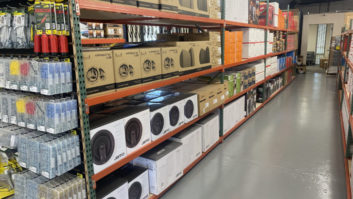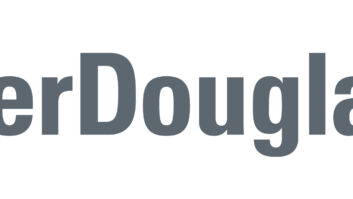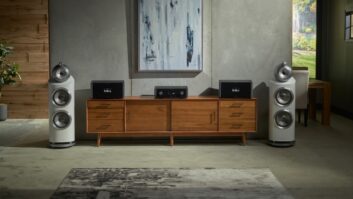HAUPPAUGE, N.Y. — Sales, margins and profits are back in positive territory at Audiovox, and company executives say they’re positioned for continued sales and profit growth, thanks in large part to an aggressive brand-acquisition strategy that accelerated in 2007.
The company is still shopping for brands, particularly in the high-margin custom-installation industry.
The acquisition strategy put Audiovox firmly in the higher-margin accessories category, enabled it to better manage channel conflicts in a highly consolidated retail market, and placed the company in a strong position to “make the cut” at a time when big-box retailers are reducing their vendor counts, Audiovox executives told TWICE.
Founder and chairman John Shalam and president/CEO Pat Lavelle told TWICE in an exclusive interview just before International CES that their ability to leverage well-known brands in mobile, home and portable electronics enables the company and its retailers to command higher margins than those offered by little-known Chinese brands entering the market.
The two executives contend they can accomplish their goals while avoiding the fate of other companies that acquired multiple brands only to subsequently stumble or go out of business. For one thing, they said, Audiovox is not overpaying for acquisitions, opting instead to buy well-known brands at a deep discount. “We have been very diligent to make sure that we did not overpay for any of the acquisitions,” Lavelle said. “That is one of the classic problems, that you overpay and can’t support [the business].” Lavelle continued, “We bought [these companies] at a very steep discount even though they were wonderful brand names with very active businesses. We were able to pay very little for these properties.”
Audiovox purchased Recoton’s electronics assets when Recoton was in Chapter 11, Shalam noted, and the RCA electronics brand has been “in disposal mode” by Thomson for two to three years. In addition, the acquisitions didn’t involve the purchase of company-owned factories.
Also to ensure future success, the company is paying for its acquisitions with cash on hand to avoid taking on high debt levels that rob companies of the capital needed to support their acquisitions. And the company is aggressively reducing the overhead of its acquisitions by leveraging existing back-office services, from IT to logistics, while letting the acquired companies focus on sales, marketing and product development, the executives added.
At the same time, Audiovox continues to “build products consistent with the brand image” of the acquired brands, Lavelle said.
With every one of the company’s acquisitions, Lavelle continued, “we were able to reduce a significant portion of their overhead by eliminating the need to have their own IT department, accounting department, logistics department, customer service department … and have them concentrate on the things that will drive sales, and that is product development and marketing.”
Besides buying brands at a good price, Audiovox is also buying brands that are “synergistic with what we do,” Lavelle said. “When we looked at the accessories business, it was synergistic. We sold a lot to the same [retail] accounts. We knew how to handle that business. It was related in some way to our audio and video business. We know the category, and when you add that to our core business, we are able to leverage our existing overhead and stay close to what we know but add new sales and add new margin.”
In the current consumer electronics marketplace, brand acquisition is instrumental to growth, Shalam added. “There are limits to how much you can grow the business organically in this very, very competitive economy,” he explained. “There is only so much you can do with internal growth within the same customer group [retailers] and the same manufacturers in Asia. You find today that business is getting more and more difficult. Major retailers are getting bigger all the time, getting much more demanding, more competitive. You have a lot of competition coming in from Asian manufacturers, many of whom would like to enter this market directly. So it’s difficult to maintain our place when we’re competing in the [consumer electronics] marketplace as well as in the mobile electronics business, which is competing against OEM.”
With the acquisitions, Shalam continued, Audiovox can focus “different lines on different types of accounts,” including 12-volt specialists, car-dealer expediters and a variety of big-box retailers.
Added Lavelle, “You need multiple brands to grow in the big-box channel.”
Besides brand acquisition, Shalam also attributed the turnaround in the first half of fiscal 2008 (see p. 32) to “overall market conditions” and “efforts to generate better sales at better margins,” but the turnaround is “in good part a result of some acquisitions we made in the past year of businesses and lines of product that traditionally carry higher gross profit margins. And combine this with more efficient operations, improved overhead, you get a better overall result.”
“There’s no question that the accessory products are making a big improvement in our overall margins,” he added. Accessories accounted for almost 27 percent of sales in the first half of fiscal 2008, up from 3.5 percent in the year-ago period, but Audiovox doesn’t plan on accessories to account for a majority of sales in the future. Lavelle forecasted accessory sales remaining in the 25 percent to 30 percent range, although the percentage might grow depending on future acquisitions.
The company’s first acquisition dates back to 2002, when it bought vehicle-security supplier Code-Alarm in large part to enter the automotive OEM business, which currently accounts for about 10 percent of Audiovox’s sales. The Code purchase was followed in 2003 by the purchase of Recoton’s family of brands for use on electronics gear after Recoton went Chapter 11.
Audiovox didn’t ramp up its acquisitions, however, until after it sold off its
margin-challenged cellular subsidiary in
late 2004, netting about $140 million that was used to buy accessory company Terk in 2005 and five more companies in calendar 2007 (see timeline).
“The strategy was to take that cash to acquire companies, to grow internally as well, but also to acquire companies that generally had a better margin structure than our core business,” said Lavelle. “And with the acquisitions that we have done, we’ve been able, especially in the accessories business, to accomplish that.”
Selling the cellular subsidiary, however, also presented challenges that, combined with a severe drop-off in the company’s mobile-video sales and margins and the decision to exit some product lines, contributed to losses in operating income in fiscal 2005 and 2006.
“We knew when we exited cellular that we were set up to be a much, much bigger company, and it took us the better part of two years to scale it down, to right-size the company but leave us in a position for us to grow through acquisitions, so we couldn’t take the overhead down too much,” Lavelle explained. “We had to leave ourselves the ability to acquire companies and handle the back end and take advantage of the synergies in the acquisitions.”
At around the same time, margins also suffered during the 2004 to 2006 fiscal years because of a “sharp decline in the mobile video business based on the car manufacturers coming out with [factory] standard programs,” said Lavelle. “That had the biggest impact on our margins. We were No. 1 in mobile video, and still are, but when the car manufacturers came out with their standard programs, we had a steep decline in sales. In our business, we have at least a six-month lead time in inventory, so we got stuck with some inventory, and we had to move that inventory. At the same time, we were going through the restructuring in cellular, and we also decided that would be a good time for us to exit some of the older product categories that were not contributing … Disposing of inventory took a toll on margins.”
With those challenges behind it, Audiovox posted net income in fiscal 2007 for the first time since fiscal 2004, saw gross margins rebound to 17.4 percent in fiscal 2007 and to 18.7 percent if the first half of fiscal 2008. That compares with margins of about 11 percent during the previous two fiscal years. Also in the first half of fiscal 2008, Audiovox posted an operating income following three years of operating losses (see table, p. 32).
For the full fiscal year, Lavelle forecasted sales growth of 30 percent, with margins drifting back to “to more normal margins,” but “as the acquisitions of the new companies take hold, and as we transition to them, we expect to see margins grow,” he said.
For video excerpts of TWICE’s interview with Lavelle and Shalam, go towww.TWICE.com.













